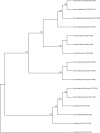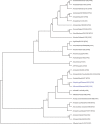Influenza in migratory birds and evidence of limited intercontinental virus exchange
- PMID: 17997603
- PMCID: PMC2065878
- DOI: 10.1371/journal.ppat.0030167
Influenza in migratory birds and evidence of limited intercontinental virus exchange
Abstract
Migratory waterfowl of the world are the natural reservoirs of influenza viruses of all known subtypes. However, it is unknown whether these waterfowl perpetuate highly pathogenic (HP) H5 and H7 avian influenza viruses. Here we report influenza virus surveillance from 2001 to 2006 in wild ducks in Alberta, Canada, and in shorebirds and gulls at Delaware Bay (New Jersey), United States, and examine the frequency of exchange of influenza viruses between the Eurasian and American virus clades, or superfamilies. Influenza viruses belonging to each of the subtypes H1 through H13 and N1 through N9 were detected in these waterfowl, but H14 and H15 were not found. Viruses of the HP Asian H5N1 subtypes were not detected, and serologic studies in adult mallard ducks provided no evidence of their circulation. The recently described H16 subtype of influenza viruses was detected in American shorebirds and gulls but not in ducks. We also found an unusual cluster of H7N3 influenza viruses in shorebirds and gulls that was able to replicate well in chickens and kill chicken embryos. Genetic analysis of 6,767 avian influenza gene segments and 248 complete avian influenza viruses supported the notion that the exchange of entire influenza viruses between the Eurasian and American clades does not occur frequently. Overall, the available evidence does not support the perpetuation of HP H5N1 influenza in migratory birds and suggests that the introduction of HP Asian H5N1 to the Americas by migratory birds is likely to be a rare event.
Conflict of interest statement
Figures



Similar articles
-
Long-term surveillance of H7 influenza viruses in American wild aquatic birds: are the H7N3 influenza viruses in wild birds the precursors of highly pathogenic strains in domestic poultry?Emerg Microbes Infect. 2015 Jun 17;4(6):e35. doi: 10.1038/emi.2015.35. Emerg Microbes Infect. 2015. PMID: 26954883 Free PMC article.
-
Avian influenza viruses in New Zealand wild birds, with an emphasis on subtypes H5 and H7: Their distinctive epidemiology and genomic properties.PLoS One. 2024 Jun 3;19(6):e0303756. doi: 10.1371/journal.pone.0303756. eCollection 2024. PLoS One. 2024. PMID: 38829903 Free PMC article.
-
Spatial, temporal, and species variation in prevalence of influenza A viruses in wild migratory birds.PLoS Pathog. 2007 May 11;3(5):e61. doi: 10.1371/journal.ppat.0030061. PLoS Pathog. 2007. PMID: 17500589 Free PMC article.
-
Origin and evolution of highly pathogenic H5N1 avian influenza in Asia.Vet Rec. 2005 Aug 6;157(6):159-64. doi: 10.1136/vr.157.6.159. Vet Rec. 2005. PMID: 16085721 Review.
-
An overview of the epidemiology of avian influenza.Vaccine. 2007 Jul 26;25(30):5637-44. doi: 10.1016/j.vaccine.2006.10.051. Epub 2006 Nov 9. Vaccine. 2007. PMID: 17126960 Review.
Cited by
-
Natural history of highly pathogenic avian influenza H5N1.Virus Res. 2013 Dec 5;178(1):63-77. doi: 10.1016/j.virusres.2013.05.009. Epub 2013 Jun 2. Virus Res. 2013. PMID: 23735535 Free PMC article. Review.
-
The Genomic Contributions of Avian H1N1 Influenza A Viruses to the Evolution of Mammalian Strains.PLoS One. 2015 Jul 24;10(7):e0133795. doi: 10.1371/journal.pone.0133795. eCollection 2015. PLoS One. 2015. PMID: 26208281 Free PMC article.
-
Phylogenetic diversity and molecular detection of bacteria in gull feces.Appl Environ Microbiol. 2008 Jul;74(13):3969-76. doi: 10.1128/AEM.00019-08. Epub 2008 May 9. Appl Environ Microbiol. 2008. PMID: 18469128 Free PMC article.
-
H9N2 avian influenza virus-like particle vaccine provides protective immunity and a strategy for the differentiation of infected from vaccinated animals.Vaccine. 2011 May 23;29(23):4003-7. doi: 10.1016/j.vaccine.2011.03.067. Epub 2011 Apr 2. Vaccine. 2011. PMID: 21463681 Free PMC article.
-
Bird harvesting practices and knowledge, risk perceptions, and attitudes regarding avian influenza among Canadian First Nations subsistence hunters: implications for influenza pandemic plans.BMC Public Health. 2014 Oct 28;14:1113. doi: 10.1186/1471-2458-14-1113. BMC Public Health. 2014. PMID: 25347949 Free PMC article.
References
-
- Hinshaw VS, Webster RG, Turner B. The perpetuation of orthomyxoviruses and paramyxoviruses in Canadian waterfowl. Can J Microbiol. 1980;26:622–629. - PubMed
-
- Kawaoka Y, Chambers TM, Sladen WL, Webster RG. Is the gene pool of influenza viruses in shorebirds and gulls different from that in wild ducks? Virology. 1988;163:247–250. - PubMed
-
- Krauss S, Walker D, Pryor SP, Niles L, Li CH, et al. Influenza A viruses of migrating wild aquatic birds in North America. Vector-Borne and Zoonotic Diseases. 2004;4:177–189. - PubMed
-
- Munster VJ, Veen J, Olsen B, Vogel R, Osterhaus AD, et al. Towards improved influenza A virus surveillance in migrating birds. Vaccine. 2006;24:6729–6733. - PubMed
Publication types
MeSH terms
Associated data
- Actions
- Actions
- Actions
- Actions
- Actions
- Actions
- Actions
- Actions
- Actions
- Actions
- Actions
- Actions
- Actions
- Actions
- Actions
- Actions
- Actions
- Actions
- Actions
- Actions
- Actions
- Actions
- Actions
- Actions
Grants and funding
LinkOut - more resources
Full Text Sources
Medical
Research Materials
Miscellaneous

